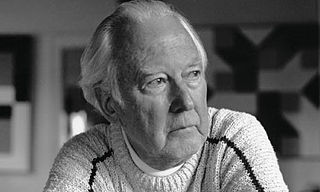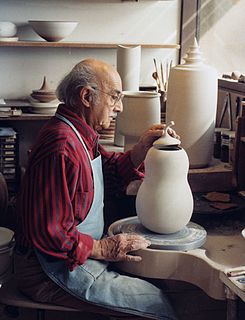Walter "Chico" Hopps was an American museum director, gallerist, and curator of contemporary art. Hopps brought Los Angeles post-war artists to international prominence in the 1960s.

Joe Goode is an American artist. He was born in Oklahoma City, Oklahoma, in 1937. In 1959 he moved to Los Angeles, California, where he attended the Chouinard Art Institute until 1961.
Allan Sekula was an American photographer, writer, filmmaker, theorist and critic. From 1985 until his death in 2013, he taught at California Institute of the Arts. His work frequently focused on large economic systems, or "the imaginary and material geographies of the advanced capitalist world."

Llyn Foulkes is an American artist living and working in Los Angeles.
Roger Edward Kuntz was a highly accomplished Southern California landscape painter and a member of the Claremont Group of painters - professors and graduates of Pomona College, Scripps College, and the Claremont Graduate School. A figurative artist with an eye for abstract form, he won critical acclaim for striking compositions that transform an unusual array of subjects, including tennis players, domestic interiors, freeways, road signs, bathtubs and the Goodyear Blimp. A retrospective exhibition of his work, at the Laguna Art Museum in Laguna Beach, CA in 2009, was aptly titled "Roger Kuntz: The Shadow Between Representation and Abstraction". In the exhibition catalogue, curator Susan M. Anderson wrote: "Kuntz's work of the late 1950s and early 1960s quintessentially embodied the experimentation, fragmentation, and paradox in American culture of the time."

Roman de Salvo(born 1965) is a contemporary American conceptual artist who creates sculpture and installation art.
Ed Moses was an American artist based in Los Angeles and a central figure of postwar West Coast art.
Craig Kauffman was an artist who has exhibited since 1951. Kauffman's primarily abstract paintings and wall relief sculptures are included in over 20 museum collections, including the Museum of Modern Art, the Whitney Museum of American Art, the Tate Modern, the Louisiana Museum of Modern Art, the Art Institute of Chicago, the Los Angeles County Museum of Art, Seattle Art Museum, and the Museum of Contemporary Art, Los Angeles.
Steve Roden is an American sound and visual artist, who pioneered the lowercase style of music; where quiet, usually unheard, sounds are amplified to form complex and rich soundscapes. His discography includes Forms of Paper, which was commissioned by the Los Angeles public library.
Maxwell Hendler is an American painter. In 1975, he became the first contemporary artist to have pictures in the collection of the Metropolitan Museum of Art in New York.
Roland Petersen is an American painter and printmaker of Danish birth. Petersen was born 1926 in Endelave, Denmark. His career spans over 50 years primarily in the San Francisco Bay Area and is perhaps best-known for his Picnic series beginning in the 1960s to today. These paintings made their debut in New York at the Staempfli Gallery.

Frederick Hammersley was an American abstract painter. His participation in the 1959 Four Abstract Classicists exhibit secured his place in art history.

Peter Plagens is an American artist, art critic, and novelist based in New York City. He is most widely known for his longstanding contributions to Artforum and Newsweek, and for what critics have called a remarkably consistent, five-decade-long body of abstract formalist painting. Plagens has written three books on art, Bruce Nauman: The True Artist (2014), Moonlight Blues: An Artist's Art Criticism (1986) and Sunshine Muse: Modern Art on the West Coast, 1945-70 (1974), and two novels, The Art Critic (2008) and Time for Robo (1999). He has been awarded major fellowships for both his painting and his writing. Plagens's work has been featured in surveys at the Museum of Modern Art, Los Angeles County Museum of Art (LACMA), Whitney Museum, and PS1, and in solo exhibitions at the Hirshhorn Museum and Las Vegas Art Museum. In 2004, the USC Fisher Gallery organized and held a 30-year traveling retrospective of his work. Critics have contrasted the purely visual dialogue his art creates—often generating more questions than answers—with the directness of his writing; they also contend that the visibility of his bylines as a critic has sometimes overshadowed his artmaking—unduly. Los Angeles Times critic David Pagel described Plagens's painting as a "fusion of high-flying refinement and everyday awkwardness" with an intellectual savvy, disdain for snobbery and ungainliness he likened to Willem de Kooning's work. Reviewing Plagens's 2018 exhibition, New York Times critic Roberta Smith called the show an "eye-teasing sandwich of contrasting formalist strategies," the hard-won result of a decade of focused experimentation.
Ilene Segalove is a conceptual artist working with appropriated images, photography and video whose work can be understood as a precursor to The Pictures Generation.

George Herms is an American artist best known for creating assemblages out of discarded, often rusty, dirty or broken every-day objects, and juxtaposing those objects so as to infuse them with poetry, humor and meaning. He is also known for his works on paper, including works with ink, collage, drawing, paint and poetry. The prolific Herms has also created theater pieces, about which he has said, "I treat it as a Joseph Cornell box big enough that you can walk around in. It's just a continuation of my sculpture, one year at a time." Legendary curator Walter Hopps, who met Herms in 1956, "placed Herms on a dazzling continuum of assemblage artists that includes Pablo Picasso, Kurt Schwitters, Marcel Duchamp, and Joseph Cornell, as well as California luminaries Wallace Berman and Edward Kienholz." Often called a member of the West Coast Beat movement, Herms said that Wallace Berman taught him that "any object, even a mundane cast-off, could be of great interest if contextualized properly." "That’s my whole thing," Herms says. "I turn shit into gold. I just really want to see something I've never seen before." George Herms lives and works in Los Angeles.
Bradford J. Salamon is an American multi-disciplinary artist who paints portraits in oils, depictions of human drama, and paintings of everyday objects. Salamon is also a sculptor, short filmmaker, curator and musician.

Harrison Edward McIntosh was an American ceramic artist. He was an exponent of the Mid-century Modern style of ceramics, featuring simple symmetrical forms. His work has been exhibited in venues in the United States including the Smithsonian and internationally including at the Louvre in France.

Ron Linden is a California abstract painter, independent curator, and associate professor of art at Los Angeles Harbor College, Wilmington. He lives and works in the San Pedro area of Los Angeles.

Michael Leslie Brewster was an American artist, recognized for coining the term “acoustic sculpture.” He worked with sound to create sonic environments beginning in the 1970s until 2016. His works were shown across the United States and Europe, and are in permanent collections, notably the Solomon Guggenheim Museum, the Fondo per Arte Italiano, Museum of Contemporary Art Los Angeles, and the Giuseppe Panza Collection.
Elizabeth Armstrong is an American curator of contemporary and modern art. Beginning in the late 1980s, she served in chief curatorial and leadership roles at the Walker Art Center, Museum of Contemporary Art, San Diego, Orange County Museum of Art (OCMA), Minneapolis Institute of Arts and Palm Springs Art Museum. She has organized numerous touring exhibitions and catalogues that gained national and international attention; among the best known are: "In the Spirit of Fluxus", "Ultrabaroque: Aspects of Post-Latin American Art", and "Birth of the Cool: California Art, Design, and Culture at Midcentury". She is also known for organizing three California Biennials (2002–6) and notable exhibitions of David Reed and Mary Heilmann. Armstrong's curatorial work and publications have been recognized by the Andy Warhol Foundation, the Center for Curatorial Leadership, the Getty Foundation Pacific Standard Time project and the National Endowment for the Arts, among other organizations.








